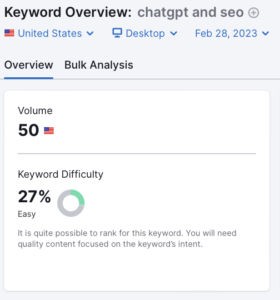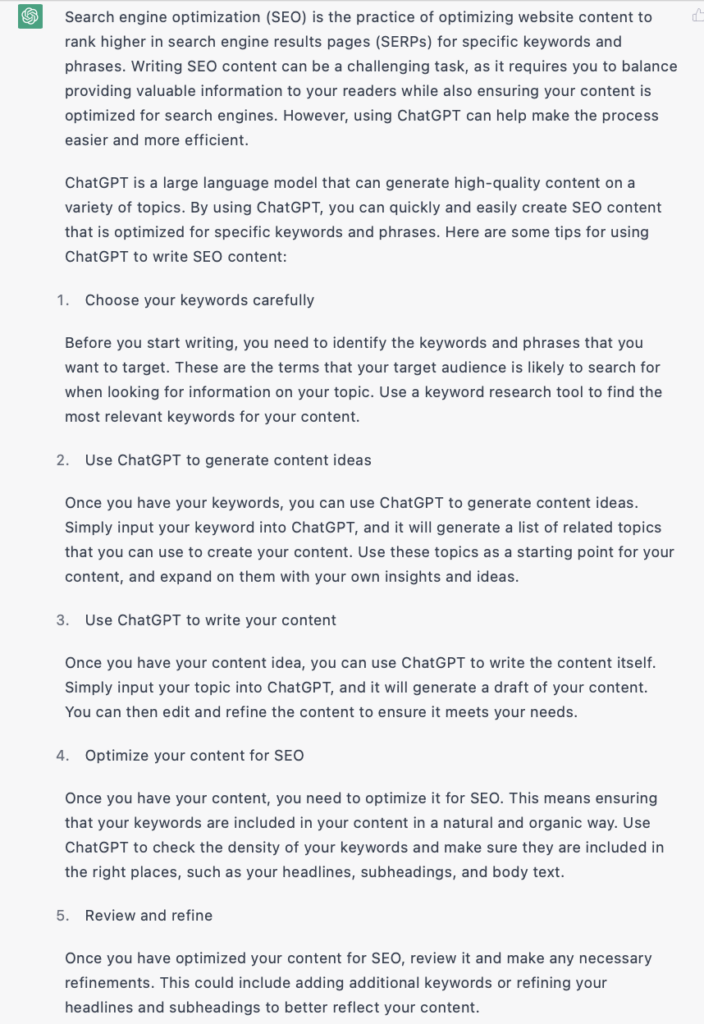For many, including myself, getting started on writing copy is a challenge. In high school and college, I would simply put words down as fast as possible so I could edit later. However, when you have several tasks to complete, trying to simply get words down on paper can feel like a real time-suck.
Every step of the content creation process requires time and effort. Fortunately, there are ways to streamline the process without losing quality.
Modern AI tools like the chatbot ChatGPTcan help you expedite the content creation process while maintaining quality by generating large volumes of text quickly in response to prompts. ChatGPT is a highly advanced AI chatbot developed by OpenAI that uses machine learning to respond to inputs.
Additionally, SEO best practiceshelp give us a picture of what “quality content” is. SEO best practices are valuable guidelines for any digital copywriter, because they promote clear, concise, people-first content that’s written for humans, not search engines.
Google’s SEO guidelines prioritize content that’s relevant to the site as a whole, as well as to users, rather than relying on questionable SEO tactics like keyword stuffing. All content should provide answers to the searcher’s questions.
Learn how to effectively utilize both ChatGPT and SEO strategies together to streamline your content creation process and create relevant, high-quality content in this blog post. To provide an example, this blog post itself is a case study for using ChatGPT as a writing companion.
ChatGPT + SEO Content Creation Steps
Find Relevant Keywords
The first part of writing quality content is to figure out what content would be relevant to your users and what keywords to use. To do this, you can use an SEO tool like SEMrush’s content idea tool or Wordstream’s free keyword research toolto generate a list of potential keyword targets.
Otherwise, if you already have a general idea in mind, you can use these tools to narrow down your focus.
Finding relevant keywords to target is critical to creating good content because it provides a springboard to creating content that’s relevant to your users and gives you information as to the freshness of the topic with keyword difficulty tools.
The image here is from my keyword research on SEMrush, which helped me locate a relevant topic within our niche with a low keyword difficulty.

Use ChatGPT to Generate a List of Content Ideas
Once you have a list of potential keywords to target, you can use ChatGPT to come up with content suggestions based on those keywords. Leveraging it to generate content ideas can save you time and give you inspiration. For example, I used the keyword I selected as a prompt to generate blog ideas using ChatGPT.
Simply ask ChatGPT to generate prompt ideas based on your keyword. When you see a topic that interests you, you can guide ChatGPT to expand on an idea or narrow down a focus until you know what to write about.
The first response gave me a variety of options, but the most interesting to me was response #5 which brought up content creation. I asked ChatGPT to drill down on that more.

After giving it a clarifying prompt, response #6 intrigued me the most. It inspired an idea I wanted to chase about how ChatGPT can be harnessed to create quality, informative content quickly. I fed it one last prompt.

I ended up going with response #6. As you can see, ChatGPT is a helpful tool that can take you from a keyword to a blog idea easily, but you simply need to steer the ship.
Using ChatGPT to Write a First Draft
After you’ve chosen a topic based on your keyword research, the next step is to actually build out the content. This is another place where ChatGPT can be helpful.
You can use ChatGPT to create a first draft of your copy, but it’s important to remember not to simply copy and paste the output as your final article. It’s helpful for getting words down and getting inspiration, but you’ll still need to edit and optimize the content.
Google will deweight content that’s clearly AI-generated spammy, irrelevant content, and if you were to use a ChatGPT generation as a blog post with no changes, it would not be helpful for users and therefore not rank well on Google.
As an example of using ChatGPT to generate content, I asked it to write this blog.

Examine, Edit, and Optimize Your Content for SEO
Once you’ve generated your first draft using ChatGPT, the next step is to examine, edit, and optimize the content.
Examine
Read through the ChatGPT-generated content and examine the structure of the piece, the jargon, the grammar, and the flow.
Edit
Review it at each level and decide what needs to be changed, and then make the necessary changes.
For example, I kept the numbered list format and the general structure of the article from my ChatGPT generation, but little besides that. It has a certain surface-level feeling to it, devoid of examples or specifics. Certain tells in the copy from my example include starting nearly all headings with ‘Once you have your…’ and the overall mechanical, predictable tone.
Optimize
Optimizing your content for SEO involves using proper heading structure, ensuring natural keyword usage, and writing in a manner that creates a clear and concise coverage of your topic. It also involves including relevant images or videos and crafting a title that accurately reflects the content and its keywords
Where ChatGPT Ends and Humans Begin
Now that you have an edited and SEO-optimized article, let’s talk about ways to fully distinguish your copy from the ChatGPT output and give it a human touch.
While Google SEO guidelines are okay with people using AI tools to write copy, one of the things they’re looking for is people-first content.
But what is people-first content? Simply put, people-first content is content that’s written for real people and real users, rather than search engines. After Google’s 2022 Helpful Content algorithm update, Google published these guidelines on what constitutes people-first content:
- Do you have an existing or intended audience for your business or site that would find the content useful if they came directly to you?
- Does your content clearly demonstrate first-hand expertise and a depth of knowledge (for example, expertise that comes from having actually used a product or service, or visiting a place)?
- Does your site have a primary purpose or focus?
- After reading your content, will someone leave feeling they’ve learned enough about a topic to help achieve their goal?
- Will someone reading your content leave feeling like they’ve had a satisfying experience?
While AI chatbots are great tools for getting you started with content, a human touch is needed to ensure that your content is focused on the user and follows the people-first guidelines.
One simple way to make your content feel people-first is to use real-life examples that a tool like ChatGPT can’t generate. Additionally, ChatGPT (for now) does not have the capability to generate images, so adding relevant images with explanations can help you build people-first content.
If you feel stuck, try to position yourself as the searcher and think about what kind of information you would want to see in the blog if you clicked on it due to the title.
Conclusion
By using ChatGPT to generate topics and content as well as SEO best practices, you can streamline your content creation process and achieve high-quality results. This approach involves finding relevant keywords to target, using ChatGPT to generate content ideas and create a draft, as well optimizing your content for SEO.
Furthermore, it’s important to remember that ChatGPT is just a tool, and humans should always give the copy a personal touch and make it people-first. Don’t just generate text, make a couple small edits and call it a day–really examine the text and ensure it flows and has a people-first approach.
Together, this approach will streamline your content creation process and help you create great content that both real people and search engines love.



